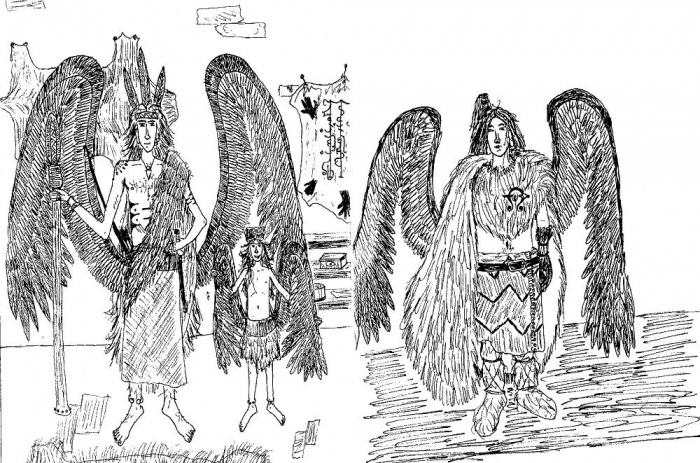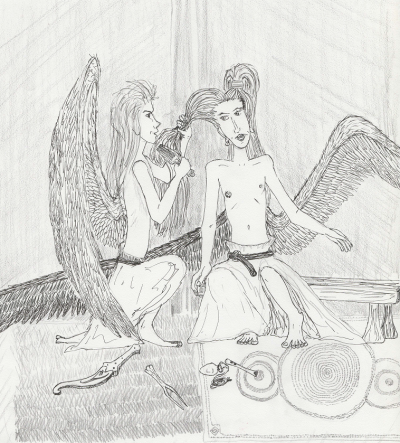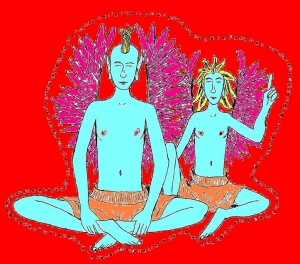Daine (The World)
Physical Description of the Daine -- There are, in general, three body types that constitute Daine physiology. These three types are Tall, Middling Height and Short. Now, we must understand here that these types are not descriptive of the several individuals of a community, but are, rather, descriptive of entire races or tribes of Daine. Within each basic type, there is some variation in stature as well.
By far, the Tall Races constitute the vast majority of all Daine. These people stand, as an average adult height, from slightly under six feet tall and do not exceed seven feet in height. The tallest of the Tall Races are the Mahrudaine, who generally average above six feet in height. The others are the Maraghdaine, the Alghadaine, the Athadaine, the Troaghladaine, the Schythondaine and the Hautherdaine. The Sharrundaine were once quite tall, it is said; but it seems that many thousands of years of living destitutely in Old Hoopelle have worn their bodies down somewhat. The average Sharrundaine is about five and a half feet tall.
Those of Moderate Height, average from around four to five feet in height. The moderately tall races are: the Aoigheldaine, the Wovydaine, the Bolghaldaine, the Antheldaine and the Scathadaine.
The only known Short Race is the Tyngadaine. They average three feet in height.
Most Daine have fairly light colored skins. The Troaghladaine, the Maraghdaine, the Mahrudaine and the Hautherdaine are able to become tanned with the Summer sunshine, and become very light in Winter. The Athadaine, the Bolghaldaine and the Antheldaine have very white colored skins that do not tan. The Aoigheldaine and several other related southern Daine races have darker skins. All the others have lighter skins, but can not tan.
One of the features that is noticed immediately on any Daine is their hair. The hair on their heads they allow to grow quite long, and only a very few ever cut it in any way, unless the ends get raggedy. They commonly braid their hair; and many simply bind it back lest it get in the way of what they are doing. The Alghadaine have no dark hairs on their bodies, having in stead only a very fine fuzz, which is practically invisible, rather like that found on a young child. Most Alghadaine consider hair on the body an unsightly blemish; and they have been known to kill youngsters who show signs of developping any. Other Daine have rather more hair on their bodies. All Troaghladaine have hairy forearms and calves; and the men have hairy chests and armpits as well. Many also have a "mane" of long hair down their spines. Athadaine have black hair on their heads; and the men grow white downy fur on their chests.
The wings are, without doubt, the Daines most visible and striking physical feature. Some Daine have longer or shorter wings than others, and the men have longer wings than the women; but all wings regardless of length are composed of the same five basic kinds of feathers. The most visible, and most highly prized by Antimoaniate dressmakers, are the long feathers. These feathers can reach lengths of two feet, and are found along the lower edges of the wings. Above these are the broad feathers, shorter feathers, six to eight inches long, and are in a band between the long feathers and the short feathers. Modified broad feathers, narrower than regular ones, are found on the area of the back between the wings and in the area between the wings and shoulder blades. Along the upper edge are the short feathers, which are from one to two inches long. In between the feathers, very close to the skin, are downy feathers, soft short feathers that provide excellent insulation.
The wingspans are different for each individual, as they are dependent on wing length. The longest wingspans are around twenty feet, assuming a seven foot tall person whose long segments reach from just above the head to the ground. The average wingspan, for a more average six foot tall person, is around fourteen feet.
The wings of birds and Daine have been likened to arms and hands, which of course Daine also have. The correlation seems true, and is corroborated by the examination of Daine skeletons during vivisection exercises. Their wings have bones analogous to the humerus, radius, ulna, and all the hand and finger bones, though some are fused. Their shoulder blades are modified to accept the upper bones, and have pockets similar to those which accept the arm bones. Some Daine have been found with a sort of thumb on the wings.
The upper two segments of their wings, corresponding to the arm segments, are about as long as their proper arm segments, so about two foot long for both together. The third segment varies considerably. Women have as a rule shorter wings, men have longer ones, and it is the "hand" or most distal segment that varies most. A womans wing might be five foot long when extended, while a mans might be eight foot long.
Daine usually keep their wings folded neatly behind them, except when doing things like talking or fighting or engaging in sex. They use wings for pointing and gesticulating as much as they do use their hands and arms to gesticulate. Had they the training in the learned skill, a Daine orator would be quite the sight! Excitement, as when old friends meet, is shown by a rapdid movement of the wing hand up to about horizontal, then back down again; very much in the manner of how our women throw their arms up in order to hug each other upon meeting. An adversarial or indignant stance is signalled by a triangular stance, where the upper segments are perpendicular to the body, the middle segments meet over or behind the head and the wing hands point down toward the ground. Their hands will also be set upon their hips. They often hug each other with their wings as well as their arms, and sometimes they entwine their legs or feet as well; and when walking side by side, people usually have their arms around each other and their wings intertwined. They spread them out a little when they wrestle or fight, and sometimes a man will try to put the long feathers at the wingtip into his opponents face to blind or distract him. Sometimes they use the bony bit at the wrist to strike an opponent. When courting, men will unfold their wings a little to show off any curve and to show off the length of their wings.
It is considered a mark of close friendship or family relationship to allow someone to preen and comb out the feathers. They use the carman an tyellow for this, and it be a narrow comb with long broad picks on one end and a single pick at the other. While Men might consider it a landmark to kiss for the first time; a Daine boy considers it quite the hurdle leapt when his lady allows him to comb out her wing feathers.
The primary feather colour generally matches the primary hair colour. So, brown haired people have brown wings; but they may also have some yellow, tan, white or even black feathers mixed in there, which are clept secondary colours. Some people have mottled patterns in their feathers; some even have mottled hair colour (areas of brown, tan or yelow). A common pattern is to exhibit darker hair and feathers on one side and lighter hair and feathers on the other. The effect is spectacular in black coloured individuals - where perhaps the left wing will have black feathers and the left arm black hair; across the chest the hair lightens and the head is a swirl of black, white and perhaps grey; the right arm is white and so is the right wing. The effect is frightening if the eyes are coloured differently as well!
The most striking feature of the Daine face is their long pointed ears. Other than this they have a similar variety of noses and mouths as do all other peoples on the Earth. Several races, most especially the Mahrudaine, the Bolghaldaine and the Tyngadaine, have rather longer jaws than the others. This gives them the appearance of having snouts like animals; especially the Tyngadaine.
Daine teeth are not so regular in size or shape as human teeth. Many races have spiky teeth, with the exception of the front two, others have several extra teeth. Those races that share longness of jaw tend to have two to four extra canine teeth, and these are often quite elongated. The Troaghladaine, Sharrundaine and several other races share wide (sometimes quite wide) front teeth, and often have rather larger teeth in general, making them usually unsuitable as objects of transplant.
The internal anatomy of the Daine has been studied to some extent in the medical colleges of both old Hoopelle and in Auntimoany. The chief difference betwixt them and Men lie in the auxilliary vessels that draw the blood from the heart to the head. In Men, there are but two, the greater and lesser vessels of the neck; Daine however have yet two smaller vessels that pass through the bones of their backs and thus may bring blood to the head when the greater vessels be sliced or blocked. There also be two sinews or nerves that pass on either side of the spine and are plainly evident upon dissection. In the pelvic regions, these sinews terminate in a passing wondrous net nigh the tail bones.
Apart from this difference, they have the usual number and configuration of other innards, though many vivisection subjects exhibit a curious reversal of their innards, such that their hearts and stomachs and gall sacks be upon the leftward; and they be largely in the same place within the recesses of the body. They have a heart that moves within the marsuppim cardialis; their lungs are two, one to each side of the heart, and draw in breath from the outer airs, and if they be stopped up a Daine will in time choke from the abuse, though it may take up to a day for them to die therefrom. In their bellies there lies the stomach, lengths of viscerales: the minor and the major, the liver, the kidneys, the bladder, the cornua uterus in the women and testicles in the men and the greater vessels that bear blood to and fro. In general, the innards of Daine have been found suitable as objects of transplant, the kidney being perhaps the easiest to manage.
Those Daine that have long faces are quite different in their internal structures. Most wondrous are their hearts, for they have two greater hearts within their chests, and four lesser ones within their bellies. Their chests be a tangle of great vessels swooping this way and that, connecting the two chief hearts and the lungs with the great vessels that rise into the neck and descend into the belly. They too have auxilliary vessels in their spines and sinews to either side thereof.


